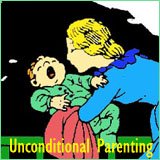Psychology Attachment Behavior: Find Out When to Expect the Constant Clinging or the Letting Go of Mom's Skirt!
Within developmental psychology attachment refers to the emotional bond that exists between an infant and his or her primary caregiver (typically his or her mother).
In psychology, attachment is referred to as an affectional bond which:
- In
attachment theory is perceived as necessary for the infant's physical and psychological survival.
- Takes the form of one of
four attachment styles which is very much influenced by the quality of attention, sensitivity and responsiveness provided by the mother.
- May either be categorized as
secure or insecure attachment both of which to a large degree shape the character of the child's self esteem, self confidence, and the expectations he or she has of e.g. romantic relationships later in life.
- Also changes in character as the child grows older ... which is what this page is about.
Here you will get the central points of attachment behavior as it gradually matures throughout the ages and stages of child development.
Please be aware that the stages of child development occur differently for each child: some children develop attachment behavior and baby separation anxiety early, some late, some a little, some a lot, some, nothing at all. And this is all ok, all babies are different.
The attachment periods below are therefore general guidelines as they are presented in attachment theory.
Attachment phases are relatively fixed periods. But again, don't be alarmed if your child does things earlier or later than indicated.
For instance my own son showed clear-cut attachment behavior and strong baby separation anxiety much earlier and more intensely than the 'average' baby (you can read about my personal experiences here).
0-2 Months:
'Warming up' the Bond

When the infant is between 0-8 weeks of age, the stage for developing secure attachment is being set.
During this pre-attachment period the mother will 'warm up' the emotional bond with her sensitive and consistent responses.
Within psychology attachment behavior of this stage is characterized by:
- Crying, smiling, babbling and sucking to achieve and maintain the attention and proximity of the mother.
The infant may distinguish between caregivers but in general displays little preference. Baby separation anxiety in relation to the mother has not kicked in yet.
2-6 Months:
Getting to Know Who Mom Is
Towards the latter part of the infant's first half year, the child starts to distinguish more clearly between known and unknown figures.
The child starts to get a sense of how his or her mother will react when they are anxious or distressed.
The infant's early expectation of his or her mother's responsiveness lays the ground for the specific attachment behavior the infant will develop in half a year's time.
Attachment behavior of this stage is characterized by:
- Reaching out for, grasping hold of and clinging to the mother (of course crying, smiling and continuous vocalizing still occurs).
6-11 Months:
The First Real Signs of Attachment Behavior
At this age and stage of child development, the baby has developed a clear understanding as to who his or her primary caregiver is (typically the mother).
This awareness often makes the mother the preferred caregiver.
Attachment symptoms of this stage are triggered by:
- Strangers: They are not yet perceived as a real threat but they may make the baby uncomfortable and wary.
- Mother leaving the room; some infants show only the beginning of baby separation anxiety other infants have separation anxiety at full throttle by now. My own
high need baby son was only about 3 months old when he would be quite upset and distressed if I left the room or was in the same room but wasn't the one holding him).
11-18 (24) Months:
The Peak of the Attachment Period:

At this age and stage of child development, the child's attachment behavior is very clear. The child is very conscious of good strategies for reaching the desired proximity of his or her mother.
Within psychology attachment behavior of this stage is characterized by:
- Clinging to, crawling and walking towards the mother if the child feels his or her security is threatened by either strangers or the mother's leaving.
- The space around the mother constitutes a secure base
from which the child feels secure enough to explore the world.
Primary caregivers and toddlers in this particular phase of attachment were used in Mary Ainsworth's psychology attachment lab experiment Strange Situation Protocol.
In the experiment Mary Ainsworth exposed toddlers to a 'strange situation' by making the mothers abandon the room, leaving the child briefly with a stranger in order to observe separation and reunion behavior.
The result of this was three (later four) different attachment styles that infants typically display when feeling distressed.
2-4 Years:
The Need for Physical Proximity Slowly Lessens
The child starts to see the caregiver as an independent person with his or her own agenda and goals. The child realizes that other people have feelings and goals and starts to navigate through this.When approaching 3 years, the child doesn't see physical separation as such a great threat anymore.
With the continual development of mental consciousness the child starts to enter a phase where negotiation and compromise can be successfully applied.
The child may be able to avoid separation distress if there is a plan for the caregiver's departure and arrival.
4-5 Years:
Attachment Behavior Still Surfaces Now and Then
This stage within child development is called the preschool stage. The child's need for independence and further exploration is growing in tune with his or her ability to cope with separation.
However, the child still faces many new skills to be acquired in a world that may still occasionally seem threatening.
So the child may still in times of distress want to stay close to his or her mother for protection, comfort and a sense of togetherness.
So according to the theorists of attachment theory and psychology attachment behavior at this age and stage of child development is not seen as childish regression.
It would more true to view it as a natural way for the child to cope with, and survive in, a world that still seems overwhelming and threatening at times.
6-7 Years:
Mom's Availability Is Enough
Attachment issues of the school age stage are less physical and more psychological. The character of the need for attachment has changed into awareness of availability rather than direct physical proximity: The child doesn't need to be near his or her mother as long as he or she knows that Mom is available if needed.
The child also starts to see the parents as partners with whom they will strive to have a fulfilling relationship which means they are more willing to make compromises that satisfy all needs and not just their own.
7-11 Years:
A Good Dosis of Mom Now and Then Will Do
Psychology attachment themes of this stage of middle childhood continue to evolve around negotiating how to maintain a secure base. The child becomes more and more active in the planning process and the need to be independent grows constantly.
Again, please note: All kids are different, and the above stages are only general and not an end result!
Your Positive Parenting Ally,
Birgitte

Want to stay in touch and get the latest news?
Sign up
for my free newsletter
Parent Coaching
- For Inner Peace, Clarity and a Deeper Connection to Your Child
 Being a parent can feel like a double-edged sword. Life with kids may feel like the greatest gift you have ever received, while at the same being hugely challenging, often leaving you confused, stressed and overwhelmed.
Being a parent can feel like a double-edged sword. Life with kids may feel like the greatest gift you have ever received, while at the same being hugely challenging, often leaving you confused, stressed and overwhelmed.
When we feel like this, we've lost touch with ourselves. We can't hear our own inner voice, and it's difficult to know what is 'right' for us and how to act.
I offer in-depth parent coaching to help you regain your balance and get back in touch with yourself. From a place of inner peace and clarity, your will find your own answers which will help you reconnect with your child from a place of unconditional love and acceptance.
Read more about my parent coaching here.
Where Would You Like to Go Next?
Attachment Parenting Articles
 Attachment Parenting and Intuitive Parenting: Read Your Child Rather Than Some Book! |
 What Is Attachment Parenting? 10 Sharp Truths and 2 Common Misconceptions! |
Attachment Theory Articles (Scientific Angle)
 Secure or Insecure Attachment in Infancy ... Largely Shapes Who We Are Today! |
 Attachment Theory is Good Basic Knowledge ... But Misses Out on Individual Infant Temperaments! |
 The Four Infant Attachment Styles: Straight to the Point, Quick Understanding! |
Attachment Experts
 John Bowlby: The Father of Attachment Theory |
 Mary Ainsworth: The Refiner of Attachment Theory |
 Deep Insights into the Essence Dr Sears' Attachment Parenting along with a Fascinating Historical View on the Slow Rising Consciousness of Attachment Parenting |
Attachment, High Need and Separation Anxiety
 A High Need Baby: A Strong Personality Is Great, But Where's the Off Button? |
 Baby Separation Anxiety The More Your Baby Clings, the More You Let Him! 10 Tips to Ease Baby Separation Anxiety |
 Valuable Insights into Separation Anxiety in Children and Babies: Meet Your Child with Full Acceptance and Deep Connection! |
 Facts and Fiction about the Controversial Ferber Method along with a Discussion of Its Potential Long Term Consequences |
Back to the top of this page about Psychology Attachment Behavior: Find Out When to Expect the Constant Clinging or the Letting Go of Mom's Skirt!
Go to the Positive Parenting Ally Homepage







